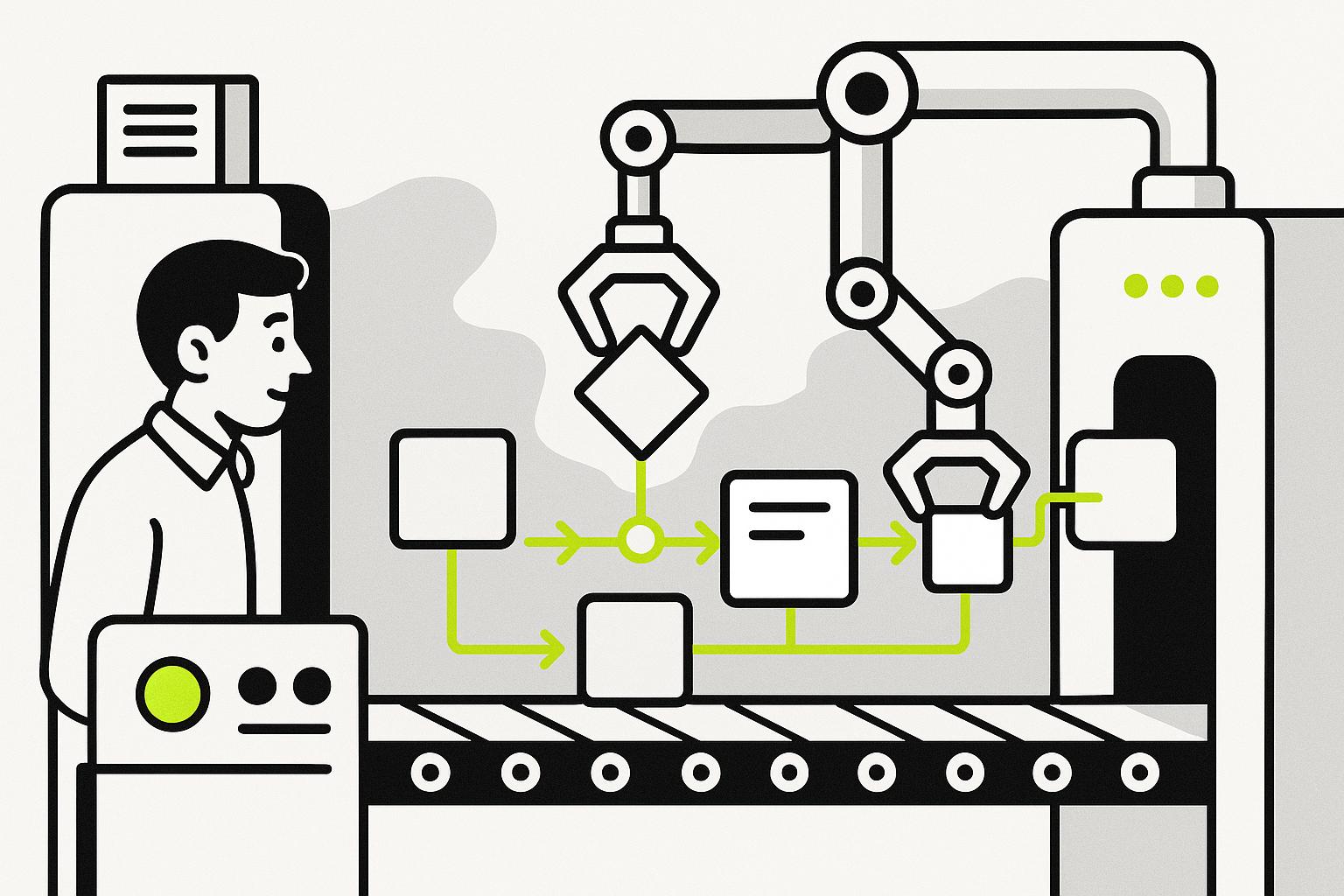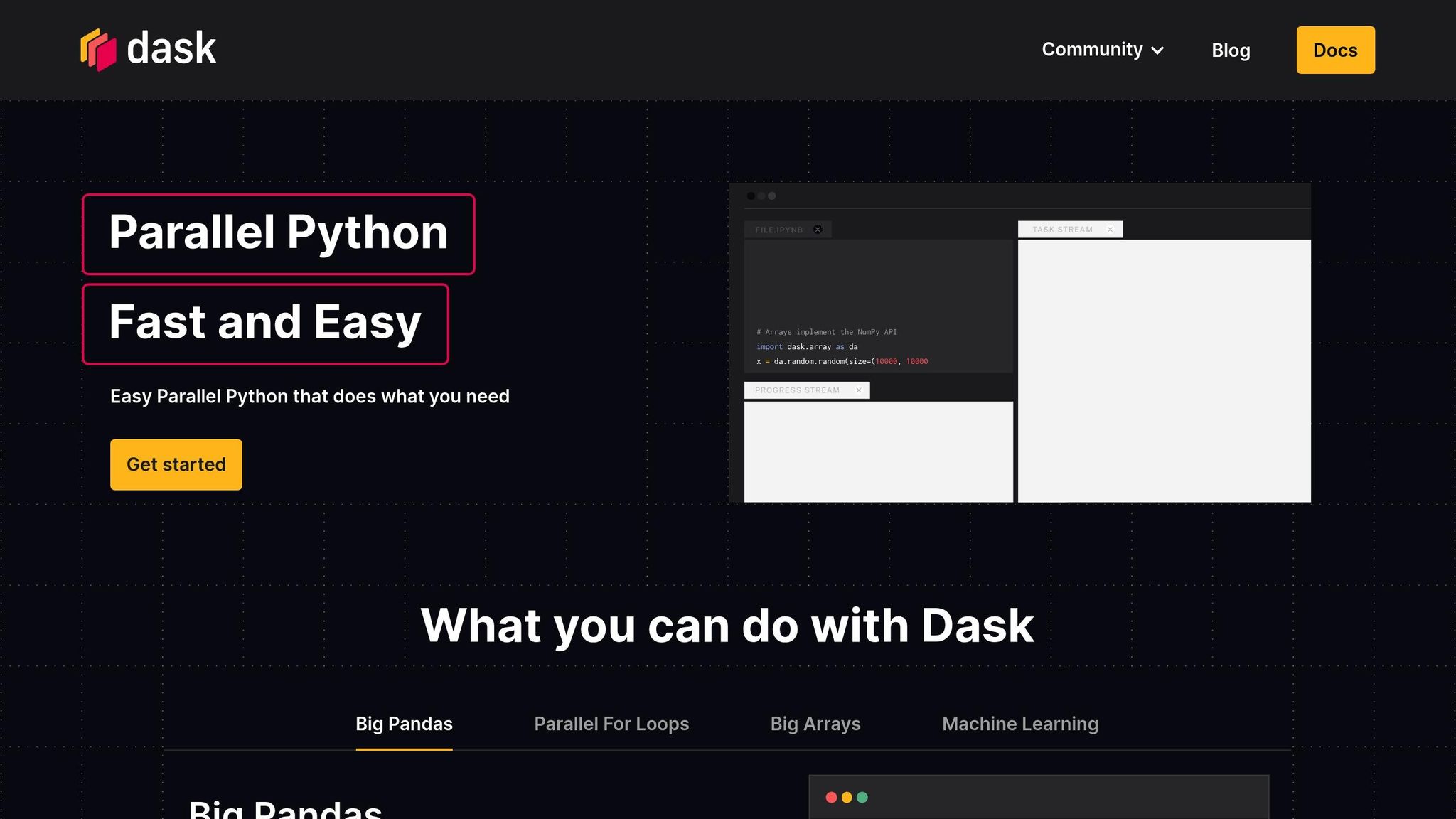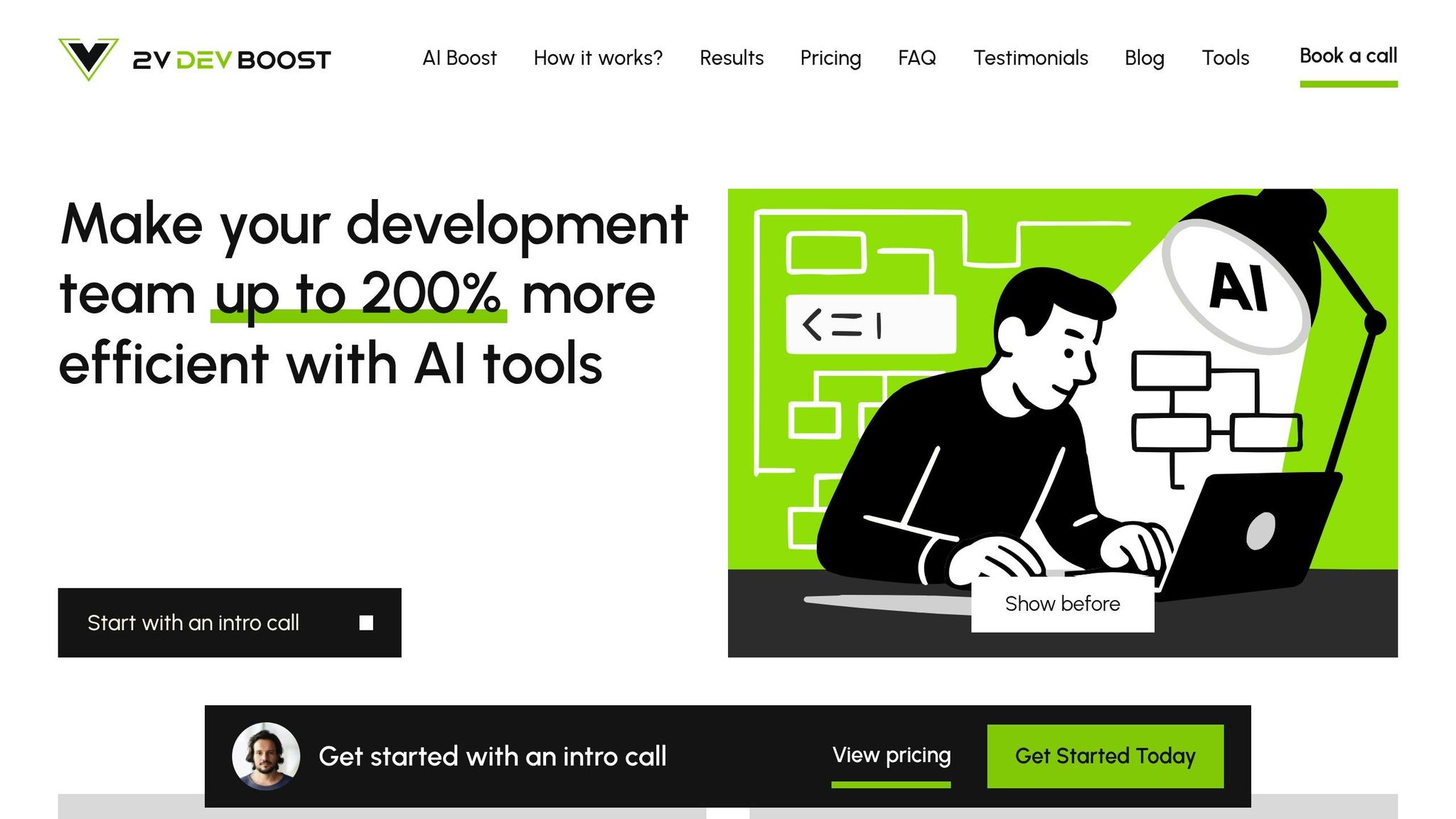

Automated release scheduling helps software teams deliver updates faster and more reliably. But as teams grow and projects become more complex, maintaining efficiency becomes harder. Key challenges include:
Solutions include adopting DevOps practices, leveraging AI for predictive scheduling, and using tools like feature flags and database sharding. Services like 2V AI DevBoost offer tailored AI solutions to improve efficiency, with pricing starting at $10,000 for small teams. The right strategy depends on team size, growth plans, and regulatory needs.

When development teams are small, managing automated release scheduling feels relatively simple. But as organizations grow, the process starts to buckle under the weight of increasing complexity. These challenges go beyond just technical hurdles - they extend to organizational dynamics, operational intricacies, and infrastructure demands that can overwhelm unprepared teams.
Scaling from a small group of developers to multiple teams spread across time zones introduces a new level of complexity. Imagine a five-person team growing into 50 people, each working with different tools and schedules. Suddenly, the informal processes that worked for a small team no longer suffice.
The main challenge is balancing standardized processes with enough flexibility for teams to operate effectively. Smaller teams thrive on informal communication and shared understanding. Larger organizations, however, require clear guidelines and centralized coordination to avoid misaligned release schedules, clashing deployment practices, and communication failures that can delay important releases.
DevOps practices provide a pathway to address this issue by promoting iterative and collaborative solutions. Establishing clear guidelines that serve as a framework, while allowing teams to customize processes to their needs, is essential. Change management also plays a critical role here. Teams need to see standardized automation as a tool that enhances their work rather than a bureaucratic hurdle. This means showing the benefits of automation and adapting workflows in ways that feel natural to developers already comfortable with their current methods.
Additionally, as release schedules expand across various systems, ensuring data integrity becomes a pressing challenge.
When automated release schedules scale across multiple systems, environments, and teams, maintaining consistent data becomes a significant challenge. Synchronization issues can lead to mismatched deployment times, outdated dependency information, and general confusion across teams.
Here's a staggering statistic: Poor data quality costs U.S. organizations around $3.1 trillion annually. A lot of this stems from synchronization failures, where conflicting information between systems erodes trust in the automation.
Netflix offers a great example of how to address this. By using a shared database strategy during deployments, they ensure real-time data consistency. They also deploy new features behind feature flags, maintaining backward compatibility while rolling out schema changes in phases. This approach has allowed Netflix to execute seamless deployments with zero downtime for millions of users.
"One of the biggest challenges in blue-green deployments is managing data consistency when both environments share the same database. While this approach simplifies the process, it requires careful planning around schema changes and backward compatibility to ensure smooth transitions without data conflicts." - Jeff Schlesinger, Enterprise Architect, Temenos
The solution? Implementing robust synchronization and conflict resolution protocols. This includes automated rollback mechanisms, strict schema versioning, and leveraging tools like AWS Database Migration Service or Azure Data Factory to reduce operational overhead.
Even with data consistency under control, network performance can throw a wrench into scalable releases. Bottlenecks and latency issues become more pronounced as automated release systems manage concurrent operations across distributed teams and data centers.
Etsy encountered this problem when their blue and green deployment environments shared a single database, leading to performance bottlenecks. Their solution was database sharding and using Varnish Cache to handle the increased load. This significantly improved deployment performance without compromising data consistency.
To address these challenges, teams must plan for performance optimization from the outset. This includes strategies like cloud scaling, edge computing, and proactive performance monitoring. Waiting to address bottlenecks until after they arise often leads to costly and time-consuming retrofits.
As release scheduling scales, security and compliance requirements grow more complex. What starts as basic access control for a small team evolves into a web of permissions, audit trails, and regulatory demands spanning multiple systems and environments.
Traditional compliance methods can't keep up with the speed and complexity of automated releases. Manual processes often lag behind, creating vulnerabilities and slowing down delivery.
"Compliance and auditing processes are often not integrated into application development and delivery workflows, hindering speed and agility and leading to poor security and compliance outcomes." - Gartner
The solution lies in embedding security and compliance into DevSecOps workflows. Gartner predicts that by 2028, 65% of organizations will adopt compliance automation in DevOps, reducing risks and improving lead times by at least 15%. This involves automating policy checks, collecting audit evidence, and using Infrastructure as Code (IaC) to enforce consistent security configurations.
By integrating security controls early in the development lifecycle, teams can identify vulnerabilities through static and dynamic analysis tools and focus on automated remediation.
As systems grow, so does the complexity of monitoring and debugging them. What starts as a straightforward deployment pipeline for a small team can turn into an intricate web of dependencies and failure points when scaled to support hundreds of releases.
Technical debt compounds the problem. Teams often find themselves firefighting issues instead of improving their automation, creating a cycle where problems accumulate over time.
While advanced monitoring tools are helpful, they aren't enough on their own. Teams need to systematically prioritize fixing technical debt that has the greatest impact on reliability and productivity. This requires dedicated resources for maintenance, not just reactive fixes when things go wrong.
The key is to build monitoring and debugging capabilities into the system from day one. This includes comprehensive logging, distributed tracing, and automated alerts that help teams identify and resolve issues before they disrupt releases. By prioritizing visibility and proactive maintenance, organizations can avoid the pitfalls of scaling automated release systems.
AI-driven solutions are redefining how teams tackle scalability challenges by offering predictive analytics and automated interventions. These tools help manage resources, anticipate bottlenecks, and streamline workflows in ways that traditional methods simply can't match. They address scalability concerns head-on, providing practical improvements throughout the release process.
One standout feature of AI in release scheduling is predictive load balancing. By analyzing historical and real-time data, AI can anticipate bottlenecks, optimize resource allocation, and prioritize deployment tasks intelligently. This approach has been shown to reduce scheduling errors by up to 35% and cut administrative overhead by 28%.
AI doesn't stop there. It examines deployment data, system performance, and traffic patterns to forecast where resources will be needed. For instance, when algorithms detect potential traffic surges, they can proactively scale resources or redirect workloads to prevent bottlenecks before they happen.
Machine learning also plays a key role in workflow optimization. It predicts peak memory usage and dynamically allocates computing resources, which minimizes delays, lowers operational costs, and even reduces energy consumption and greenhouse gas emissions.
Beyond resource management, AI automates critical tasks like dependency resolution and rollback planning, enhancing both system performance and security. It addresses challenges such as data synchronization, performance bottlenecks, and compliance issues. Additionally, AI-powered systems can identify and mitigate DDoS attacks by distinguishing between legitimate traffic and malicious activity.

Implementing these AI strategies effectively often requires specialized expertise, which is where 2V AI DevBoost steps in. This service offers a 5-week AI sprint designed to audit workflows, recommend tailored AI tools, and provide step-by-step guidance for seamless implementation - whether for small teams or large enterprises. The results? Efficiency gains ranging from 15% to 200%.
The process begins with a detailed workflow audit to pinpoint bottlenecks in release scheduling. Based on these findings, 2V AI DevBoost suggests AI solutions with the highest potential impact. Their support includes creating detailed roadmaps, hands-on assistance during deployment, and guidance on integrating AI tools to automate repetitive tasks.
Pricing is structured to accommodate teams of various sizes: $10,000 for teams of 5–10 members and $40,000 for enterprises with 51–100 members. Each engagement includes a post-implementation review and ongoing retainer support to ensure the AI solutions adapt to your evolving needs.
2V AI DevBoost also offers expertise in dynamic project prioritization, real-time capacity monitoring, and integrating AI-driven load balancing with security measures like firewalls and intrusion detection systems. With 77% of businesses already exploring or using AI and 35% actively implementing these solutions, 2V AI DevBoost provides the tools and expertise to scale your release processes effectively while keeping pace with organizational growth.
The table below outlines various scalability strategies, weighing factors like cost, performance, and control. It’s designed to help you decide which approach works best for your organization based on your unique needs and constraints. Each strategy comes with its own set of advantages and challenges, so understanding these trade-offs is key to making the right choice.
| Strategy | Pros | Cons | Best For | Typical Cost Range |
|---|---|---|---|---|
| Centralized Scheduling | • Single point of control and oversight • Easier to standardize processes • Simplified compliance management • Unified monitoring and reporting |
• Can become a bottleneck as teams grow • Risk of single point of failure • Limited flexibility for distributed teams • Latency issues with remote deployments |
Small to medium co-located teams Industries with strict regulations |
$25,000–$75,000/year |
| Decentralized Scheduling | • Scales well with larger teams • Faster local decision-making • Greater team autonomy • Reduced single points of failure |
• Inconsistent processes across teams • Higher coordination overhead • Data synchronization challenges • Complex compliance management |
Large distributed organizations Teams with autonomy in decision-making |
$50,000–$150,000/year |
| Cloud-Native Approach | • High scalability and elasticity • Reduces operational overhead • Built-in automation options • Rapid resource scaling |
• Risk of vendor lock-in • Requires expertise in cloud technologies |
Teams prioritizing automation Organizations experiencing rapid growth |
$30,000–$120,000/year |
| Edge Computing | • Low latency for distributed systems • Improved performance for global applications |
• More complex to manage • Challenges with monitoring |
Applications with global reach Latency-sensitive deployments |
$75,000–$200,000/year |
| Fully Automated | • Faster feedback loops • Fewer human errors • Enhanced collaboration • Consistent deployment quality |
• High initial setup costs • Requires specialized expertise • Troubleshooting can be complex • Risk of over-automation |
Established DevOps teams High-frequency deployment environments |
$40,000–$100,000/year |
| Partially Automated | • More flexible adoption • Lower upfront costs • Gradual implementation possible • Retains human oversight |
• Requires more manual effort • Higher risk of inconsistencies • Slower release cycles • Greater error potential |
Teams new to automation Organizations with tighter budgets |
$15,000–$50,000/year |
Take, for example, a U.S.-based fintech company that transitioned from centralized to decentralized scheduling. This shift reduced deployment times by 30%, although it did result in higher annual monitoring expenses.
Centralized systems often demand significant scaling investments, while decentralized and edge-based approaches, despite higher upfront costs, can deliver better long-term efficiency for growing organizations.
Regulatory demands play a critical role in strategy selection as well. For instance, financial services and healthcare sectors tend to prefer centralized systems for their straightforward audit trails. On the other hand, tech firms with global operations might lean toward edge computing, even though it introduces additional complexities.
Ultimately, your choice should consider factors like team size, projected growth, regulatory requirements, and technical skillsets. Many organizations find that hybrid models - combining centralized oversight with decentralized execution - strike a practical balance between control and scalability.
Managing the challenges of scaling automated release scheduling is critical for maintaining team productivity. Issues like team expansion, process standardization, data synchronization, performance bottlenecks, security compliance, and technical debt demand thoughtful and adaptable solutions.
Companies such as Microsoft, Netflix, IBM, and Atlassian have already embraced AI-driven tools to tackle these challenges. For example, Microsoft uses a release gate system in Azure DevOps, while Netflix relies on canary analysis in Spinnaker. These implementations demonstrate how automation can forecast risks, streamline workflows, and deliver measurable results in addressing scalability challenges.
The strategies discussed highlight that there’s no universal solution. Whether it’s centralized scheduling for regulatory needs, decentralized approaches for team independence, or cloud-native methods for rapid scaling, the best choice depends on aligning your strategy with your organization’s unique requirements and growth plans. This flexibility lays the groundwork for further AI-driven advancements that can refine and simplify these processes.
AI tools play a vital role in building scalable systems by automating tasks like dependency checks, predictive scheduling, and rollback planning. These tools not only reduce manual work but also enhance reliability. The importance of flexible scheduling is clear, with 84% of employees and 78% of employers agreeing that it significantly boosts productivity and morale. Getting this aspect right is crucial for long-term success.
To ensure scalability, organizations should take a proactive stance. Regular performance audits and stress tests can help identify potential bottlenecks before they disrupt operations. It’s also essential to plan for future needs by evaluating systems with a 3–5 year horizon in mind. Implementing changes through phased rollouts, starting with pilot groups that reflect diverse scheduling scenarios, can smooth the transition.
Services like 2V AI DevBoost further support this effort by auditing workflows, recommending effective AI tools, and guiding implementation. These structured approaches have shown efficiency gains ranging from 15% to 200%, making them a valuable resource for organizations looking to optimize their processes.
In today’s fast-paced development environment, addressing scalability in automated release scheduling is no longer optional - it’s a necessity. Companies that invest in scalable, AI-driven solutions now will position themselves to deliver high-quality software quickly and reliably in the future.
To keep data consistent and synchronized in large-scale automated release scheduling, you need to rely on effective data replication techniques. These involve automated systems that ensure data is copied accurately and updated in real time across all platforms, keeping datasets aligned and error-free.
Using multi-cloud synchronization frameworks and specialized tools built for large-scale operations can also enhance reliability while cutting down on delays. These approaches ensure a steady and consistent flow of data, even during complex deployments, helping to avoid disruptions and reduce the chances of errors.
When it comes to tackling performance slowdowns and delays in automated release scheduling, AI steps in as a game-changer. With the help of machine learning, AI can analyze system performance in real time, spotting bottlenecks and pinpointing exactly where the release process is being held up.
On top of that, AI keeps an eye out for latency problems and unusual behavior, while also fine-tuning resource allocation to keep workflows running smoothly. These tools allow development teams to address potential issues before they escalate, helping to deliver faster, more dependable releases and boosting overall productivity.
Security and compliance play a key role in scaling automated release scheduling. They ensure that every release aligns with regulatory, legal, and industry standards while protecting sensitive data. Overlooking these areas can open the door to vulnerabilities, legal troubles, and operational hiccups.
To tackle this effectively, teams should weave automated compliance checks into their CI/CD pipelines. Establishing clear policies for handling security updates is equally important, alongside leveraging tools that provide real-time monitoring and detailed audit trails. Addressing these elements early in the release process helps organizations reduce risks and keep operations running securely and efficiently.